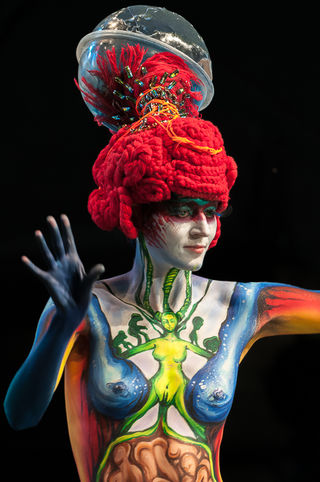Beauty
"Skin Wars" — A Lesson on the Significance of Body Painting
Body painting isn't only beautiful. It's also a tool for teaching and survival.
Posted February 18, 2020 Reviewed by Daniel Lyons M.A.

I have to admit: I am a sucker for reality TV. It feels so good to watch something “easy” after a day of teaching and researching at my university.
There is nothing shameful about doing something that helps you to unwind, but sometimes I do try to rationalize my reality TV love by thinking about it differently: reality TV is not only fun, but it is also a window to current societal discussions (e.g., how the “me too” movement was reflected in the previous season of Survivor) and provides real-life examples of classic concepts in psychology (e.g., the forming of social hierarchies within a Survivor tribe).
When I started watching Skin Wars, I didn’t expect to learn anything bigger than the show. For those of you who don’t know, Skin Wars is a show where body painters compete in body-painting challenges to win a cash prize. It turns out, Skin Wars led me to some really interesting research about body painting and its importance in past and present societies. Let me give you two examples.
Example 1: Body painting as a teaching tool
In Season 2 of Skin Wars, the body painters were asked to “reveal” their model’s body below the skin, for example by painting her muscles, organs, and bones. The result was beautiful (albeit creepy) models who looked like they were walking around with their flesh torn open.
I learned later that body painting is actually a very important tool within medical schools around the world. In class, students practice painting the anatomy of the body on each other. The research shows that not only is the technique fun, but it also helps students to better remember the anatomy they painted, to develop better physical perceptions of the body, and to learn how to better interact with patients (and who among us hasn’t wondered why doctors cannot have better bedside manners?).
But wouldn’t it be awkward to have fellow students paint on your bare skin? Or to paint on theirs? Apparently, the research shows that students don’t experience much embarrassment, especially when their trainers show confidence. And, of course, students can always choose to be painted on top of their clothes, or to not be the “canvas.” This may be desirable within cultures where revealing one’s body is less socially acceptable.
Example 2: Body painting as a survival mechanism
In the opening of Skin Wars, Season 2, models are painted to look like animals and prowl through a makeshift jungle. Through body painting, the models become fascinating human-animal hybrids.
I came across a fascinating study, which showed that painting stripes on the human body – emulating those of a zebra – can protect people from being attacked by disease-carrying insects.
The researchers described how darker-skinned animals and/or those with “plainer” coat patterns tend to fall prey to insects like horseflies, whereas those with lighter skin and/or more “complex” coat patterns seem to have a protective advantage. They wondered whether, in humans, ancient practices of painting the body with intricate patterns like stripes, which have been common among peoples in Africa, Australia, Papua New Guinea, and North America, not only served a cultural and religious function, but also a life-saving function of protecting them from pests.
To test their idea, they conducted a field experiment where they placed three mannequins in the outdoors. Mannequin 1 was painted dark brown, Mannequin 2 was painted dark brown with thin white stripes that are commonly used in body paintings, and Mannequin 3 was painted beige (as a control). The mannequins were covered in a special substance that captured any horseflies that landed on it. Over the course of several weeks, they collected and counted the trapped horseflies.
The results showed that Mannequin 1 (dark brown) attracted 10 times as many horseflies as Mannequin 2 (white stripes). Further, Mannequin 3 (beige) attracted twice as many horseflies as Mannequin 2. Thus, body painting helped to protect Mannequin 2 from horseflies.
The authors underscore how body paintings are first and foremost an expression of a person’s culture and religion. But, the fact that body painting also seems to protect humans from annoying and potentially disease-carrying insects, is a valuable byproduct of this practice.
Take-home messages
To summarise, these two areas of research show that body painting is a helpful tool within medical schools, and that body painting has also protected humans from insects that could carry diseases. I find it pretty neat that my foray into body painting – which started as a “guilty pleasure” watching Skin Wars – led me to this knowledge.
The research is also interesting because it reminds me of the incredible power of the human body. As my own research shows, we all-too-often focus on the human body as something that is to be looked at and valued based mainly on its physical appearance. Many of us live in a society that portrays one kind of beauty, and an unrealistic one at that. It’s important to focus more on the functions of the body. What are the things that our body can do, and why is that important to us? My research shows that these questions help people to feel more positively about their bodies.
With respect to Skin Wars, although body painting is undeniably a visible, beautiful art, it is also a functional one. And that is something to appreciate.
References
Finn, G. M. (2010). Twelve tips for running a successful body painting teaching session. Medical Teacher, 32, 887-890.
Horváth, G., Pereszlényi, Á., Akesson, S., & Kriska, G. (2019). Striped bodypainting protects against horseflies. Royal Society Open Science, 6, 181325.
Alleva, J. M., Martijn, C., van Breukelen, G. J. P., Jansen, A., & Karos, K. (2015). Expand Your Horizon: A programme that improves body image and reduces self-objectification by training women to focus on body functionality. Body Image, 15, 81-89.




